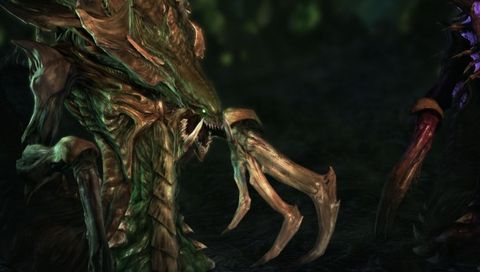Our Verdict
A traditional RTS essential for anyone interested in competitive strategy games, and highly recommended for anyone who isn't.
PC Gamer's got your back
StarCraft 2: Heart of the Swarm was designed to be a competitive sport, so it's only fair that it nicks some of sport's idioms. The most important of these is cribbed from football: it's a game of two halves.
The front half: a 20-odd mission campaign with a steadily evolving spread of controllable units spurred on by an earnest, overwrought story of revenge. Dig through that, learn the game's many long and greasy ropes, and you'll find the back half: a competitive strategy game so finely balanced and so tactically varied that people are able to play it as their job.
"Watching your host chew Terrans into scrap metal and ripped flesh is consistently enjoyable."
No matter your experience with Heart of the Swarm's predecessor, Wings of Liberty - first of Blizzard's planned three StarCraft 2s - it's the campaign you should start with. Not simply because it does an appreciable job of teaching new players the basic mechanics for one of the game's three races - the Zerg, the swarmy stars of this StarCraft show - but also because it's incredibly well put together in its own right.
Heart of the Swarm delivers on its titular promise early on, quickly gifting players with control of masses of units. The Zerg are numberless in the game's fiction, and this justifies control of a screen-filling carpet of Zerglings a few missions into the campaign. Wolf-sized Zerglings, like many of the Zerg's units, are cheap, quick to produce, and disposable in application. But in giving me control of such a vast number of them, Heart of the Swarm not only cemented the differences between it and predecessor WoL, it made me feel powerful . Pointing a host of clawed monsters at a Terran target and watching them chew it into scrap metal and ripped flesh is consistently enjoyable - especially with a physics engine that now ensures torsos and limbs go flying into the distance with appreciable force.
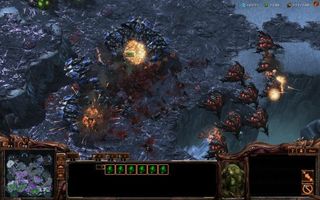
At the heart of said swarm sits Kerrigan. She's the game's cover star, and comes in two flavours in both HotS and the series fiction. She started life as a Terran ghost: a human super-sniper with brain-melting psionic powers. After some advanced Zerg gribblification, she grew a natty pair of bony wings and had her entire body turn sparkly purple, taking on the moniker 'Queen of Blades'. It's no spoiler to mention she flits between these forms in Heart of the Swarm - the game plasters her Zergified face all over the loading screen - but no matter her appearance, she retains a set of enemy-shredding abilities that get more powerful as the story progresses on.
"When it tries to be po-faced, it's quite silly; when it tries to be silly, it's very silly."
That story is silly in varying ways, with varying degrees of success. Kerrigan begins proceedings trapped in a Terran lab. Semi-friendly to her captors - Valerian Mengsk, son of Terran despot Arcturus Mengsk, and other friends of her beau Jim Raynor - she's no longer in her guise as the Queen of Blades, de-Zergification having rendered her more human in appearance. A breakout is followed by daddy Mengsk's intervention, and Kerrigan is propelled back toward her Zerg swarm, and re-de-re-Zergification.
Her story is one of blind, stabby revenge, a tale of crossing the galaxy and interacting with its most powerful beings with the express intentions of offing one beardy dude for being really, really annoying. When it tries to be po-faced, it's quite silly; when it tries to be silly, it's very silly, a pulp sci-fi story dictated by the surprise success of characters and plot coined in the late 1990s. It feels like a resurrection of that era of nuance-less science fiction - a time when space marines could be space marines, horrible chitinous monsters could be horrible chitinous monsters, and the two could fight without origin stories or complex motivations - but Blizzard are happy to embrace StarCraft's origins, not attempt a reboot.
In embracing it, they justify Kerrigan's semi-mystic power, and subsequently her in-game powers. These increase in impressiveness as she levels up: an early ability enables her to lift a handful of enemies into the air, their little arms waving as Kerrigan's army nibbles at their legs; a mid tier skill lets her conjure six acid-filled Banelings out of the ground, ready to hurl at nearby opponents. Her final few abilities are ridiculously powerful: one allows her to call in her vast Leviathan ship. The beast hovers malevolently around the map, prodding things to death with sandworm-sized tentacles.
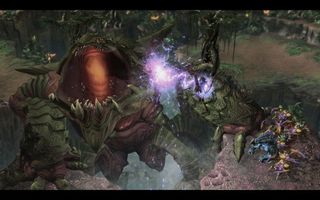
The Leviathan skill can be replaced by a portable nuke, or by a set of drop pods Kerrigan can call in to spawn an entire army at a moment's notice. Her skills sit on a tech tree, and demand that players choose between two (later three) abilities at certain levels. Kerrigan acts like an action-RTS hero on the battlefield, and players have the ability to outfit her for a range of functions. She can be given a set of healing and buffing auras and told to stand next to the bulk of your army, or you can build her - as I did - for pure damage output, speeding deep into enemy ranks, chucking blasts of kinetic energy, and darting back out with a city-sized spaceship in her wake.
"Your newest organic toy is always ideal for the mission ahead - but victory is never assured."
That's not the only action-RTS influence in Heart of Swarm's campaign. A number of missions feature the endless streams of dumb AI units that characterise that genre (originally born from Blizzard's games: the circle is complete). One mid-campaign level is fringed by a constant battle between two rival Zerg factions. Their two streams meet at the bottom of the map, extra forces sometimes spilling off to attack Kerrigan and her own brand of Zerg at the top of the area. The persistent creep conflict is technically superfluous to completing the mission - Kerrigan need only survive for 25 minutes - but a bonus objective requires crossing the stream, necessitating a serious battle plan on higher difficulties.
All of Heart of the Swarm's campaign missions are this thoughtful. The story introduces new units at a deliberate pace, inevitably making your new organic toy ideal for the mission ahead - but victory is never assured by simply building lots of new unit X. Each mission has a gimmick to go alongside its new Zerg arrival: an early stage on the ice world of Kaldir introduces flash freezes that root the local Protoss to the spot for a minute at a time, allowing systematic destruction of their bases. A later mission asks Kerrigan to harvest meat from indigenous creatures on a jungle planet: a task that required me to build up my base, push out onto the map with a sizeable force, kill the critters, send a worker Drone to collect the meat, and protect it on its journey home, all while stopping my opponent's forces from destroying my meaty treats or attacking my base directly.
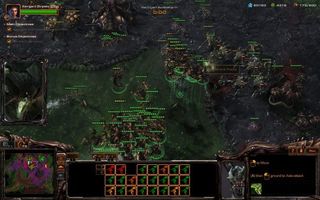
There's no one way to win in singleplayer. Chris - playing the game through on hard - had trouble with a level that introduced Swarm Hosts to Kerrigan's arsenal. He ended up eschewing the pustule-covered siege units entirely and built up a combined force of Roaches and Banelings to win the day. I took a different path and spawned a flock of Mutalisks to do the same job in another way.
"The Zerg army Kerrigan controls is made powerful by multi-tasking and distributed thinking."
This choice is hardcoded into the game. As well as Kerrigan's personal tech tree, I was able to choose one of three specialisations for each of my units - increased health, damage, or speed, for example - decisions I could alter between missions. Heart of the Swarm also offers irreversible decisions: each controllable unit earns an evolution mission that displays two options for improvement - players have to pick one. I gave my Zerglings wings, letting them jump up cliffs, made my Roaches spit debilitating acid, and tweaked my Ultralisks so on death, they crawled inside a cocoon and came back to life a few seconds later.
Later levels give Kerrigan full control of the swarm's Zerg strains and multiple bases from which to produce them. On normal difficulty, these felt more like showcases than strategy - too hard to lose against a lacklustre enemy showing, and more an opportunity to breed a few of my favourite units and give them names. There's less time to introduce people to Charles von Broodlordingtons on hard and brutal difficulties. These demand serious skill and RTS mechanics, particularly when the Zerg army Kerrigan controls is made powerful by multi-tasking and distributed thinking. If you can hack these, you'll do well on Heart of the Swarm's multiplayer ladder.

That multiplayer forms Heart of the Swarm's second half. It shares units with the campaign, but there are hefty differences: it's played at 'faster' speed compared to the campaign's 'normal', and it assumes a familiarity with keyboard shortcuts, expansion timings, map knowledge and unit counters that the singleplayer rarely does.
"HotS doesn't remove any units from Wings of Liberty's online mode, resolving to tweak rather than cull."
It's almost exactly the same as Wings of Liberty's multiplayer. Heart of the Swarm doesn't remove any units from that game's much-loved hyper-competitive online mode, resolving - after threatening to ground the Protoss Carrier spaceship - to tweak rather than cull. Some examples: Terran Reapers still jump up cliffs and carry infantry-shredding pistols, but they no longer require a tech lab attachment on a barracks, and now regenerate a small amount health over time. Medivacs still heal nearby biological units, but now come with turbo-charged boosters that grant them a few seconds of faster flying time.
The Medivac speed upgrade allows Terran players to multi-task with abandon, dropping squads of infantry units in vital places across the map. Before, they would've lost said squad had the enemy reacted fast enough; now, they can simply pack them up and boost off into the sunset. The Terran versus Zerg matchup was once dominated by Siege Tanks - now players, from professional down to the online ladder's bronze league denizens - are using Medivac drops against Zerg opponents.
A few tweaks were more substantial. The Protoss Mothership was little used by the race's players, crowd's often cheering if one was constructed in a professional game. Now it's available earlier, for cheaper, as the Mothership Core. It comes with the same range of abilities, but a drastically reduced health pool, making its application complicated, but rewarding: mass recall allows careful Protoss to surgically strike their opponent's base before flitting back home in an instant to avoid danger.
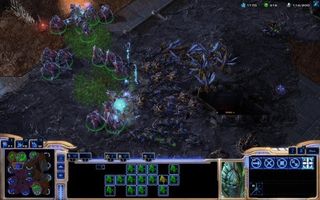
Tweaked units are joined by downright new ones. Strangely, for a Zerg-focused expansion, it's the Protoss who've earned the most interesting addition: the Oracle is a fragile floating green bulb that can destroy worker units in a few blasts from its lasers. It also comes packaged with a set of spells that careful Oracle drivers can use to aid their army, or provide vision of an enemy base. The professionals are yet to figure out its correct usage, but it's Heart of the Swarm's most interesting new multiplayer unit.
"Tweaks and additions change the complicated metagame in wonderful ways."
Pros have had less trouble figuring out the new Terran Widow Mine. Mines can burrow - in this position they hop out of the ground and latch themselves onto anything that steps within their radius, blowing up and beginning a 40-second cooldown before they can re-explode. Widow Mines were the breakout stars of the most recent Major League Gaming championships, Terran players finding hidden, automatic bombs easier to use than the Protoss's complicated Oracle.
These new units are rounded out by one or two additions per race: the Zerg Viper and Swarm Host, the Protoss Tempest, and the Terran Hellbat. To the untrained eye, these are small, piffly changes that feel like a poor haul given three years of development time. Those untrained eye owners will see the same StarCraft 2 as before, a thimble-full of new units changing very little: the actual mechanics of competitive, base-building, classic RTS are unchanged.
But even to my semi-trained eye - I've logged more than 500 hours of Wings of Liberty 1v1 multiplayer - these tweaks and additions change the complicated metagame that's built up around StarCraft 2 in wonderful ways. The Oracle promotes Protoss harassment and multi-tasking, a first for the race that's relied on sitting back and building up multi-unit 'deathballs' before rolling over the map like a golden fist. The Zerg Viper and Swarm Host finally give the swarm the options to deal with Terran Siege Tank lines, the latter distracting the Tank's guns while the former yanks it out of position with its abduct skill. And the Terrans have already altered fundamentally at the hands of highly skilled players: once the turtler's favoured race, they're now characterised by multi-pronged assaults and fine control.

Heart of the Swarm's success comes in opening Wings of Liberty's superlative multiplayer up, making a variety of strategies viable again, rather than perpetuating the one right way to play a match-up. It also retains that game's fantastic matchmaking system: Wings of Liberty sunk its talons into me on launch when I played my first online game and eked out a win, the game matching me against a player of similarly limited skill. It's StarCraft 2's ability to provide a consistently close, tense match that makes it such a thrilling multiplayer game, and Heart of the Swarm chooses opponents that suit my skill level: after fifty multiplayer games, I've won about half of my games - the ideal percentage.
"It's SC2's ability to provide a close, tense match that makes it such a thrilling game."
But none of Heart of the Swarm's multiplayer additions and tweaks will mean a thing if you're not invested in the process of playing online and increasing your ladder ranking. Those people have a fifteen hour glossy, deep, and - on harder difficulties - strategic campaign to busy themselves with. Those Wings of Liberty veterans for whom the campaign is a distraction from the process of league ranking promotion will find an essential multiplayer mode made all the better for its new faces.
Those who bounced off both of StarCraft 2's halves with Wings of Liberty's launch won't find anything to draw them in here. Beyond balance changes and nods to MOBA design, Blizzard are playing the same classic RTS game as they were in the late 1990s, one that can feel anachronistic and dated against more forward-thinking strategy peers. But both parts of Heart of the Swarm's RTS whole - multiplayer esport and solo campaign - are so finely balanced and so cleverly produced that, to borrow another sports idiom, Blizzard have moved the goalposts.
A traditional RTS essential for anyone interested in competitive strategy games, and highly recommended for anyone who isn't.
